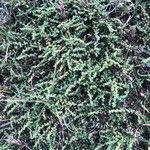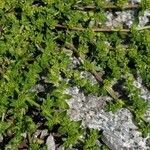Plants annual or perennial, yellowish green. Stems spreading, 5--18(--35) cm, glabrous or thinly pilose. Leaf blade elliptic-obovate, 3--7 × 1--3 mm, glabrous, base cuneate, apex obtuse. Glomerules leaf-opposed, 6--10-flowered. Flowers 5-merous, 1.2--1.5(--1.7) mm. Sepals ovate-oblong, ca. 1.5 × 0.5 mm, glabrous, apex obtuse. Stamens 5, short. Style 0.2--0.3 mm; stigma lobes nearly sessile. Achene ovoid, longer than sepals. Seed flat-orbicular, ca. 0.5 mm in diam. Fl. Jul, fr. Aug--Sep.
Freely branched, mat-forming, subglabrous annual or perennial; lvs numerous, subsessile, 2–6 × 1–3 mm or some smaller; interpetiolar stipules 0.5–1 mm; fls congested in small cymose axillary (or seemingly lf-opposed) clusters (the clusters sometimes forming short axillary branches), 4–5-parted, 0.5–1 mm; stamens 2–5; staminodes 4–6; 2n=18. Native of Europe, casually intr. here and there in our range.
A herb.







